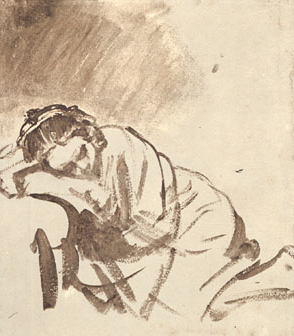For untrained artists the problem of seeing lies in the inconsistency that exists between the actual visual reality of an object and the way the brain attempts to represent our perception of this reality on the drawing paper. This attempt always involves the tendency to draw our symbolic preconception instead of the actual reality.
Symbolic preconceptions are part of a subconscious visual language that uses symbols to represent known subjects. This language of symbols evolved as a mechanism to help us survive as a species. These symbols help us, for example, to instantly recognize food sources or dangerous predators.
When we view an unknown object our subconscious mind immediately tries to form a new symbol to represent and store the object in memory. Often beginning artists will more accurately draw unknown objects than familiar ones because they are not yet married to the new symbols.
However, when they try to draw the same object a second time, it is likely that a more symbolic image will emerge because ready to use symbols have already been stored in the brain.
Consider, for example, the word “head”. Immediately an image comes to mind which is symbolic for the head. Unfortunately, this symbol is only a schematic representation of a head and is invariably a gross simplification of a real head. Nevertheless, there is a strong subconscious pull to draw the symbol instead of what we actually see.
It is this conflict that artists must try to overcome. This is particularly a problem for pencil portrait artists. When drawing a portrait the artist must resolve numerous layers of symbols to achieve a realistic effect.
We now will describe a very good exercise to learn to avoid the problem of symbol drawing.
We will be drawing from an upside-down photograph. This way our symbolic preconception of the head is disrupted. We will be required to draw without our symbols. The result will be a purer drawing occurrence unfettered by a tainted perception.
As you draw the lines and block in the values you will feel quite awkward in your drawing. This is a good thing. Do not be overly concerned of how your drawing looks. This is an exercise in seeing.
When practicing line and tone this way, beginning artists often get better results than from the right-side up way. Trust yourself and throughout the exercise only look at your photograph in the upside-down position even though it may feel quite uncomfortable.
You will learn to see and draw tone as shapes and will be able to break down hard edges into short, straight lines instead of the usual symbols your brain will give to the nose, the ears, etc.
Thinking of and naming perceived objects will lead you down the garden path of almond shaped eyes, two holes for nostrils, a bunch of lines for hair, cauliflower ears and something that looks like the letter M located on a bowl for a mouth instead of what is actually there.
Artists will never be free of symbolic preconceptions. The symbols actually adapt and become more complicated. It is by constantly analyzing and abstracting form that we are able to draw realistically.
Remi Engels, Ph.D., is a pencil portrait artist and oil painter. He is also the creator of a popular Free Pencil Portrait Drawing Course. Get your free copy here: Free Pencil Portrait Course while supplies last. Also, glimpse some of Remi’s pencil portraits at Remi’s Pencil Portrait Web Site.
For the art of another kind – game art – read these PlayStation 3 pre order tips.
[ad#review-2a]

